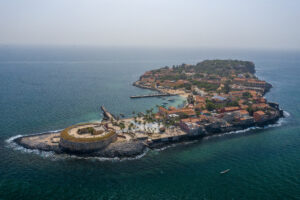
The Call of Ancestry
Have you ever felt the pull of a place you’ve never been, yet somehow know in your bones? The thought of going to Africa stirred something deep within me. My heart surged with excitement, curiosity, and an inexplicable sense of homecoming fueled by stories my mother shared about my great-great-grandmother, Caroline Davidson.
Caroline crossed the Atlantic Ocean in the belly of a slave ship as a young girl, and though centuries separated us, her journey would become the compass for my own. I hear, envision, and feel the cries of pain, hunger, beatings, and rape. I smell the stench of body excrement coming from bound bodies for days, weeks—time that is endless.
Once landed, she became the property of Banker Davidson, in Salisbury, NC. At some point he raped her and she bore a female child by him, Lydia; mother of my Mother’s father, Lafayette Henderson. Caroline worked from dawn to dusk in the fields. When she got word of freedom for the slaves, she demanded her free papers!
“I wan mys papers!” “What you talkin bout girl?” “You know damn well what Iz talkin bout, mys free papers.” He saw fire in her eyes, with a steady fearless gaze that said, I mean business and I’m not taking no for an answer! “Give me mys papers now or else!” “Or else what?” “Or else I’ll pull down your britches and sho you for the low-down scoundrel you really is!”
Years later, an article appeared in the local newspaper and became part of the local library microfiche system. It read, “Caroline Davidson – First Slave to Get Her Freedom Papers in Salisbury, NC.”
Freedom Papers and Resilience
The injustices that enslaved people endured—and the struggles that continued after freedom—speak to yet another example of humanity’s capacity for cruelty. The lynchings that took place in Salisbury during the slavery period and early 1900s are chronicled in a historical marker erected in the city in 2021. Finally, the city acknowledged its painful history. That marker stands less than a mile from where Caroline once demanded her freedom papers.
Walking those same streets generations later, I felt the weight of these connections, the thread of resilience that runs from Caroline’s defiance to my own journey back to Africa.
The Journey to Goree Island and the Door of No Return
Traveling to Senegal, West Africa in 1980 brought back not only the memories of Caroline but also thoughts of her tireless energy, her dreams of freedom, and my own curiosity about our ancestors.
My husband Bob and our 12-year-old nephew joined this journey. They too have vivid recollections of Mother Africa. Picture standing at the very entrance to a dungeon. It’s literally an opening where boats pulled up and “live cargo” was forced from the stone prison with dirt floors. This is Goree Island, off the coast of Dakar. known as the House of Slaves.
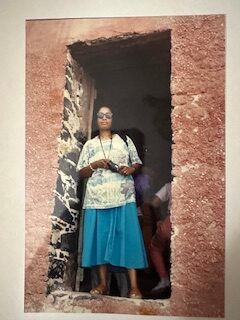
Standing at “The Door of No Return,” my body froze as I gazed out over the Atlantic. This narrow stone doorway was the last piece of African soil countless ancestors touched. It held me in place as centuries of history pressed against my chest.
The rhythmic waves below seemed to carry whispers and cries across time. Imagine the agony of being forcefully stolen from your birth land, stripped of your identity, family ties, language, and religion for free labor. Imagine being treated as less than human, considered property that could be insured, compensated for if lost.
History Made it Personal
The United States was built on the foundation of this dehumanizing system. From the Constitution’s three-fifths compromise to wealth generated by forced labor, every level of American society was structured around this brutal institution. The true history expands beyond Caroline Davidson to millions of souls. It represents an American story that must not be denied. It will not be erased, even as books are removed from schools and terms like “Improper Ideologies” attempt to cover the deception.
As I stood there, history wasn’t abstract. It was tangible. The facts illuminated in the 1619 Project echoed in my mind. I considered how my family’s journey was part of this larger narrative. Politicians like Senator Cotton dismiss this legacy as a “necessary evil.” I felt the truth in my bones. These ancestors, whose presence I now sensed, had built a nation that often refused to acknowledge their contributions.
This sacred moment transcended my thoughts of Grandmom Caroline. Suddenly, I felt myself connecting with millions of souls who passed through this doorway into unimaginable suffering. Tears streamed down my face, and something extraordinary happened. I hadn’t called upon my ancestors, yet I felt their presence envelop me—not with grief and pain, but with profound love. Their energy surrounded me, as if to say, “We are here. We have always been here. And we love you.”
In that transcendental moment, the boundary between past and present dissolved, and I understood this journey was about sacred healing across generations.
Want more stories like these? Subscribe to our newsletter, Journeys of the Soul, for bimonthly reflections, spiritual travel insights, and first look at new tours.
Returning to the Motherland
My husband Bob and I traveled to West Africa when our children were old enough to understand our connections to Africa. My son was 13 and my daughter, 11. We joined The Coalition of 100 Black Women on a 13-day journey through Senegal, the Gambia, and Juffere, the island Alex Haley references in his book, Roots. Though Juffere was a poor island ruled by an elderly queen, it had become a pilgrimage site because of Haley’s groundbreaking work.
Roots and Cultural Exchange
For the first time in American television history, a show of this magnitude depicted Black people from the standpoint of their African roots. Finally, the story was told of people with rich ancestral histories. This was revolutionary storytelling that challenged the narrative that our history in America started only when we arrived in chains.
The Coalition was on a mission of cultural exchange and education. We visited schools and mosques, delivered school supplies, and engaged in meaningful discussions with community leaders. In just seven days, we tried to take in Africa, only to learn the continent resists being rushed. The reality is that two days disappear to travel before you even begin. Thirteen days offered space to breathe, to connect, to truly take her in.
With more time, we were able to make genuine connections with local people, discover authentic places to eat and shop, and embark on extraordinary tours that would have been impossible to rush through. We visited nomadic families in the desert and explored Touba, the magnificent mosque outside Dakar. Even with nearly two weeks, we barely scratched the surface of what Africa had to offer, but those experiences were transformative.
Continuing the Journey
In 2017, I embarked on another journey to South Africa, this time with my sister and 3 other women. It, too, was a 13-day trip. The friend who suggested the trip had been to South Africa 7 times! She loves the culture and is a shopper. We were free to schedule our time and activities. We found Cape Town especially picturesque. The port city sits on a peninsula beneath the imposing flat-topped Table Mountain and pulses with a lively culture you can’t miss.
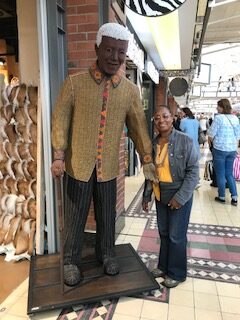
Taking in as much as we could, we visited Robben Island, the notorious prison that once held Nelson Mandela. I peered into the small space where this man of honor, truth, and conviction was confined for 27 years, awestruck by his strength.
Standing in that cramped cell, I couldn’t help but reflect on the ugly forces of apartheid—the systematic oppression, land seizures, and belief in white superiority that had torn this nation apart. The majority of the land has still not been returned to the rightful owners. Yet in spite of these ongoing injustices, the people have remained steadfast and proud.
Echoes of Apartheid
We traveled on to Johannesburg, South Africa’s largest city that began as a 19th century gold-mining town. Soweto was once the home town of Nelson Mandela and Desmond Tutu. Mandela’s home is now a museum. This museum and the others in Soweto convey the struggle to end segregation and apartheid.
Walking through Mandela’s modest home-turned museum, I found myself drawing connections between my family’s American story and South Africa’s apartheid struggle. The images of segregated facilities and protest marches felt hauntingly familiar – echoes of America’s Jim Crow era that my grandparents had lived through.
As I studied the artifacts of resistance, I imagined Caroline’s fierce determination reflected in the faces of the anti-apartheid activists, that same unquenchable thirst for dignity and freedom that seems to flow through Black experience across continents and centuries. These weren’t separate histories I was witnessing. They were different branches of the same tree, roots intertwined beneath the surface of our collective memory.
Carrying Africa Within
While none of my subsequent visits to the Motherland have touched me like the first, all these experiences offered sacred gifts and remembrances of my tangible and spiritual connections to Africa.
Each time I visit Mother Africa, love greets me. I hear, ‘Welcome home!’ In Zulu, Sawubona means ‘I see you’—such powerful words. I felt this truth on all three trips: Africans saw me as American, even in traditional dress. They recognized a story carried in me. Some of us know our stories, some do not. Even clothed in African garb, they sensed we were not from there, though our ancestors were. Through their eyes, we became legacies returning, souls making our way back home.
The word “Sankofa,” that comes from the Akan language of Ghana, means returning to your past to retrieve it. It also means knowing the importance of learning from the past to move forward. This is one way of learning, demonstrating and opening a sacred connection to the Mother Land.
A Legacy Continues: The Universal Connection
My journeys to the Motherland have taught me that our stories—like Caroline’s demand for her freedom papers—are not just personal histories but threads in a much larger tapestry. The ancestral connections I felt at the Door of No Return weren’t confined to that sacred space. They travel with me, informing how I move through the world and how I share these experiences with others.
Sharing my story has been a life-changing experience. When I tell my children and grandchildren about Caroline Davidson’s courage, about the ancestors who surrounded me with love at Goree Island, or about walking the same grounds as Mandela, I’m not just passing down family history. I’m inviting them to recognize their place in an unbroken spiritual lineage. They see themselves not just as Americans, but as part of an ancient African diaspora with roots deeper than slavery, stronger than oppression.
The youth in my family now have the opportunity to continue this legacy. They can carry these connections forward while creating their own relationships with the Motherland. When my granddaughter first heard about Caroline demanding her papers, her eyes widened with pride. “That’s where I get it from,” she said, recognizing her own determination in her story. This is how healing happens across generations—through recognition, through claiming our wholeness despite a history that tried to fragment us.
Healing Across Generations
The name and life of Caroline Davidson, like all our ancestors’ stories, weaves a fabric that forms an essential piece of the universal life puzzle. From the Door of No Return to the freedom papers in Salisbury, from Robben Island to the streets of Soweto, these seemingly separate narratives reveal a profound truth: we are not as disconnected as we’ve been taught to believe.
In Zulu, “Sawubona” means “I see you,” but it carries a deeper significance—”I see your humanity, your dignity, your soul.” When we truly see each other across time and space, across oceans and generations, we recognize that every soul in the universe plays a vital role in our collective story. The wonder of it all—the bigger picture that reveals itself when we follow the call of ancestry—is that we are not separate but profoundly connected.
As the elders in Ghana would say, “Sankofa”—reach back to move forward. My journeys to Africa have taught me that looking backward isn’t about dwelling in pain; it’s about reclaiming wholeness. The ancestors who surrounded me with love at the Door of No Return weren’t calling me to sorrow but to recognition: We Are One. This is the most precious gift the Motherland offers to those of us who make the journey home. It’s not just a connection to the past, but a more complete understanding of who we are in the present, and who we might become in the future.
About the Author
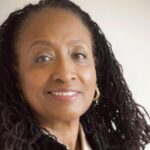
Wilhelmena Calland is a retired educator and continues to enjoy working with youth at The Center of Peace where she worships. She gains immense pleasure from her travels throughout the world, nature, gardening and the beach. Writing about her great great grandmother and her visits to “The Motherland” has opened her up to an expanded knowledge of her family lineage. Through sharing her ancestral journey, she hopes to inspire others to explore their own spiritual connections to heritage and place.
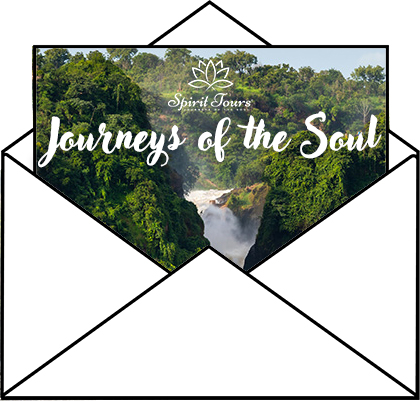
Know someone who would love this, too?
Refer a friend to join our email community—earn
rewards as they subscribe
